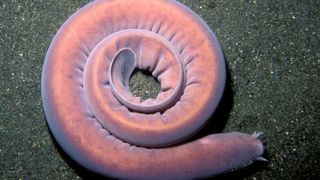Pacific Hagfish: The ancient deep-sea creature that can can choke a shark by spewing slime
This eel-like fish lives on the seabed over 300 feet below the surface where it feasts on dead animals and protects itself from attack using a suffocating slime.

Name: Pacific hagfish (Eptatretus stoutii)
Where it lives: Cold water seabeds around the world, usually below 300 feet (90 meters) deep
What it eats: Small invertebrates and dead animals that fall to the seafloor
Why it's awesome:
At first glance, these primitive fish are striking thanks to their unusual appearance.
With no fins or scales, these pinkish-gray fish look more like giant earthworms gone wrong with rows of frightful teeth spewing from their jawless mouths.
The ancient animals have been on the planet for over 500 million years and can grow up to 25 inches (64 centimeters) long. Although they look like eels, they are a type of fish called a cyclostome and are related to lampreys. They have a skull but no jaw.
Sign up for the Live Science daily newsletter now
Get the world’s most fascinating discoveries delivered straight to your inbox.
But when under attack, hagfish reveal their most impressive feature — spectacular slime that can take down a shark.
When a predator comes near, hagfish shoot out a sticky slime to clog an attacker's gills. "We've never seen a successful predation on a hagfish by any gill-breathing predator," Tim Winegard, who studied hagfish slime while a student at Chapman University in California, told science podcaster Alie Ward on her Ologies podcast.
An individual has special glands that contain slime threads and can store around 38 inches (96 centimeters) of them within each square millimeter of its skin . "They would never be caught without slime, ever. They just have so much on board," Winegard said.
This incredible ability was made clear during a 2017 traffic accident, when a truck full of hagfish that was en route to South Korea — where hagfish are considered a delicacy — overturned on an Oregon highway, coating the road with oozing slime.
Related: 100-million-year-old hagfish complete with slime kit discovered
"They generally make the slime as a defense against predators, but they also do it when they are stressed out, and being dumped onto a highway counts as stress for a hagfish," Douglas Fudge, a comparative biologist and hagfish expert at Chapman University in California, told Live Science at the time.
These creepy creatures are scavengers, eating whale fall and other decaying tissue from animals that sink to the seafloor. This helps to keep the ecosystem clean and cycle nutrients around the deep sea.
Hagfish don't eat often so when they do, they gorge themselves. "Even in captivity we only feed them every three to six months," Winegard said.
Hagfish have poor vision so they rely on their excellent sense of smell to find a meal. "Four tentacles around their mouth help them to find prey while two pairs of teeth-like projections on their 'rasping tongue' help tear and carry food into their mouth," according to the Ocean Exploration Trust's Nautilus Live.

Melissa Hobson is a freelance writer who specializes in marine science, conservation and sustainability, and particularly loves writing about the bizarre behaviors of marine creatures. Melissa has worked for several marine conservation organizations where she soaked up their knowledge and passion for protecting the ocean. A certified Rescue Diver, she gets her scuba fix wherever possible but is too much of a wimp to dive in the UK these days so tends to stick to tropical waters. Her writing has also appeared in National Geographic, the Guardian, the Sunday Times, New Scientist, VICE and more.
Most Popular



